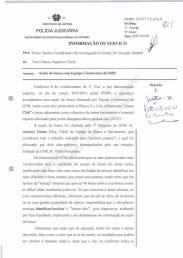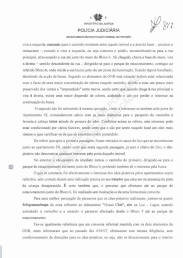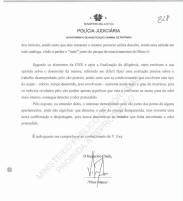|
03_VOLUME_IIIa_Page_825 |
 |
|
03_VOLUME_IIIa_Page_826 |
 |
|
03_VOLUME_IIIa_Page_827 |
 |
|
03_VOLUME_IIIa_Page_828 |
 |
Pages 825-828
Service Information 9 May 2007
To Dr G Amaral
From Vitor Matos, Chief Inspector
Search by GNR dog team
- As you know, yesterday, 8 May 2007 at 23h45, the
undersigned joined a search effected by the GNR dog team
which targeted Blocks 5 and 4 of the Ocean Club resort and
adjacent areas, with the objective of trying to reconstruct
the possible route taken by the missing child on 3 May 2007.
- The search was led by GNR 1st Sergeant A.F.Silva, head of
the search and rescue team who coordinated all the work done
by the "dual track" [method] which was performed by two
tracker dogs with their handler, GNR officer P.Fernandes.
- The members of the GNR advised that the tracker dogs are
trained to search mainly in rural areas, given the fact that
the best capability of the animal is to identify a different
and strong smell in a wide, open area, it being sure that in
terms of timing they said that after 48 hours from the event
it is difficult to obtain positive results. Concerning urban
areas, or areas with identical characteristics, they advised
that due to the fact of there being a large number of odours
in the air, it becomes impossible for the tracker dog to
manage to identify/locate the "target smell", because it is
diffuse [dispersed; broken up], [the dog] ending up becoming
confused and indicating its disinterest in continuing the
search.
- Ahead of this type of operation, taking into account the
time it is done, as well as the heat [temperature] that is
already felt, the results that might be obtained are
relative, given that the dog will confirm all the odours
that it senses, it being sure that it will seek [track]
where they [the smells] are most active, namely where
apartments were occupied. Also, any noise [disturbance] the
dog perceives inside an apartment could stimulate its
interest.
- The GNR team performing the search had in its possession,
packed in a plastic bag, a towel supposedly used to clean
the missing youngster - Madeleine McCann - furnished by her
parents.
- After the conditions for the search are met, the two GNR
officers - the leader and the dog handler - gave the scent
towel to one of the dogs to smell and led it into Block 5.
- The search started with the dog walking the several floors
of the building, always being encouraged by the handler to
"seek". It is true that the dog showed most interest at the
doors of some apartments while not approaching others. In
none of these actions did the dog signal to its handler that
it had detected the missing youngster, but it is certain
that it showed most interest next to, and around, apartments
5J, 5H and 4G. It is noted that next to 5H there were two
bags of rubbish which immediately 'conditioned' the search
because the smell was intense and the dog went to check. The
opinion of the GNR officers was decisive in affirming that
the dog was only checking that strongest odour to try to
find the small from the towel.
- Concerning outside 4G there was found a tray of used
[dirty] plates, cutlery and cloth napkins, it being sure
that it is in this apartment that the parents of the missing
child are currently staying. Once again it was the opinion
of the GNR team that the dog was 'conditioned' by the small
of the food remnants.
- Regarding the interest in 5J, the dog could have been
'conditioned' by the possible presence of people inside,
along with a smell that it wanted to confirm at the cracks
[gaps] around the door, it being understood from the signals
it gave to the handler that it was trying to confirm the
presence of the intended [hunted] scent.
- From this search the GNR team members are decisive in
affirming that the fact that the dog "signalled" those
apartments doe not mean it detected the smell of the missing
child, but merely that the strongest odours existed at those
specific locations.
- Completing the internal search of Block 5 - the verandas
of access to the apartments - and when outside, the dog
turned toward [directed itself to] Block 4. However, at the
corner of Block 5, it turned left heading for the path
between the building and the leisure area - pools and
restaurant - going on to turn left [again], i.e. going
around the building, setting out for the main street,
crossing the road to the wall of Block 6. There, it sniffed
the bottom, turned to the right - going down the road -
taking itself to the car park next to Block 6 where its
search [took it] to a lamppost where it then became confused
and stopped the search. According to the GNR team this
situation could be due to the fact that the strongest
concentration of smells on that path, due to it being a
little more preserved from the wind and "protected" between
walls, it being certain that when it arrived at the main
street and turned to the right, there was a major dispersal
of odours, causing the dog to lose interest in continuing
the search.
- The second dog was submitted to the same operation, also
showing interest at door of 5J, namely it scratched with it
front paws at the veranda parapet and lifted its head to
sniff the air to find a scent. As noted above, this interest
was conditioned by various things, it being certain that the
dog sensed a strong odour in that place and wanted to check
that [if] he had found the intended scent there.
- After the first search the two rubbish bags were removed
from 5H so that during the second one there was no smell of
rubbish, and the [second] dog showed no interest at the door
of that apartment.
- Outside, the dog immediately followed the same path as the
first, taking itself to the car park next to Block 6 where
it also lost interest in the search.
- It is true to say that the dogs effectively showed
interest in the above-mentioned apartments, without giving
an indication needed to their handler that they had [found]
the presence of the trail of the missing child. It is also
certain that the course that they made to the car park next
to Block 6 was done without hesitation and in a most
convincing manner.
- To better understand the routes taken by the dogs, there
are attached four images/maps of the area of the Ocean Club
resort, the route taken by the dogs from Block 5 to the car
park being marked in red and yellow.
- Further, in an informal conversation with the GNR team,
they advised that on the 4 May they had done the same work,
with no control over the direction taken by the dogs, i.e.
they were not directed into the buildings, it being certain
that they took the same route described above, with the same
attitude, losing the trail next to the car park of Block 6.
- According to the GNR team and after the work was finished,
they gave their opinion about what had happened, saying it
is difficult the be precise about the dogs' achievement
given the conditioning factors involved - smells, time of
day, area concerned - adding still more the degree of
uncertainty, because the clues revealed by the dogs can only
be significant by confirming if in an area of intense odour,
the intended [hunted; sought after] smell is found.
- Laid bare, in their understanding, the interest
demonstrated by the dog at the doors of some apartments can
not signify that the scent of the missing child was
detected, but solely a mere confirmation and going off track
[straying], because it never showed the handler that it had
found the intended scent.
This is all I wish to bring your attention.
Chief Inspector
Vitor Matos.